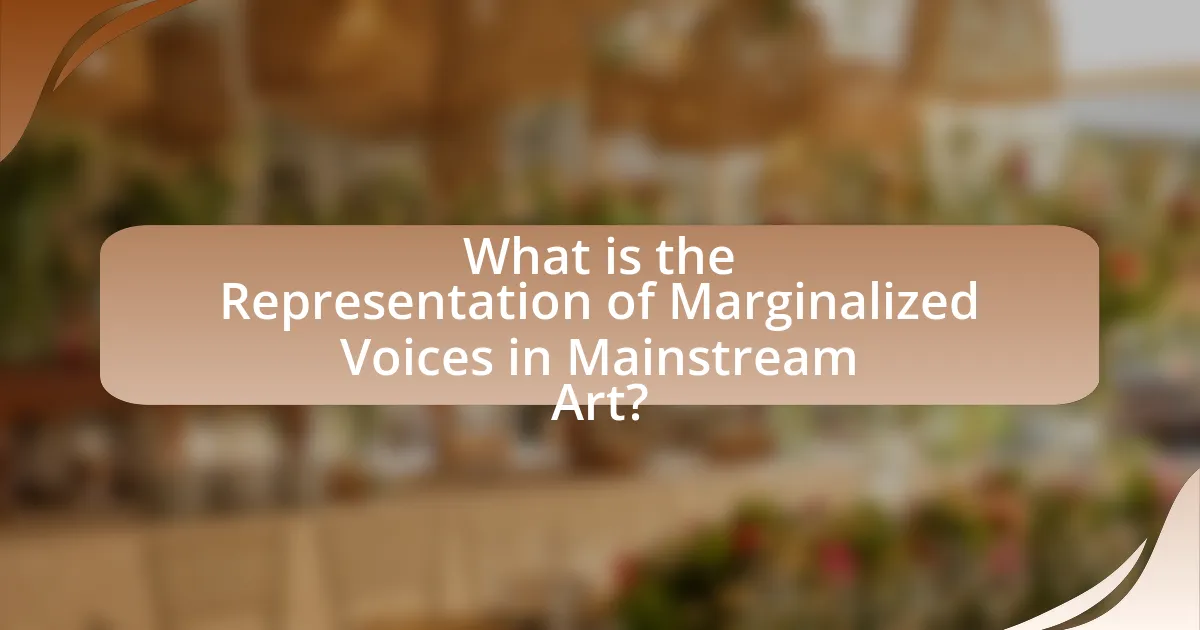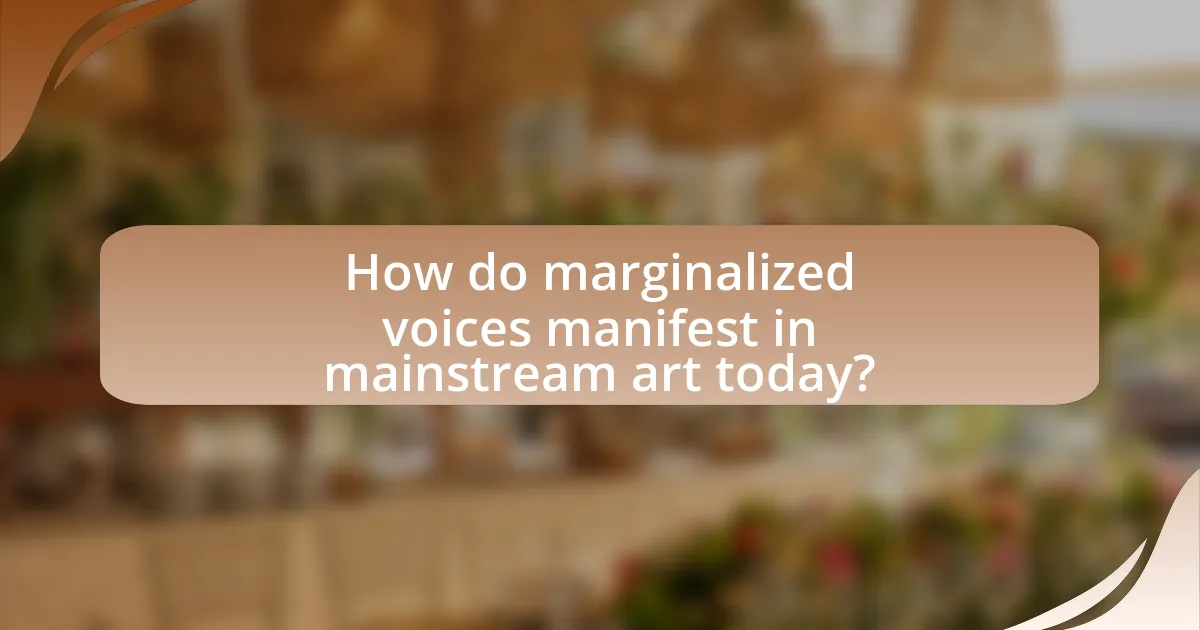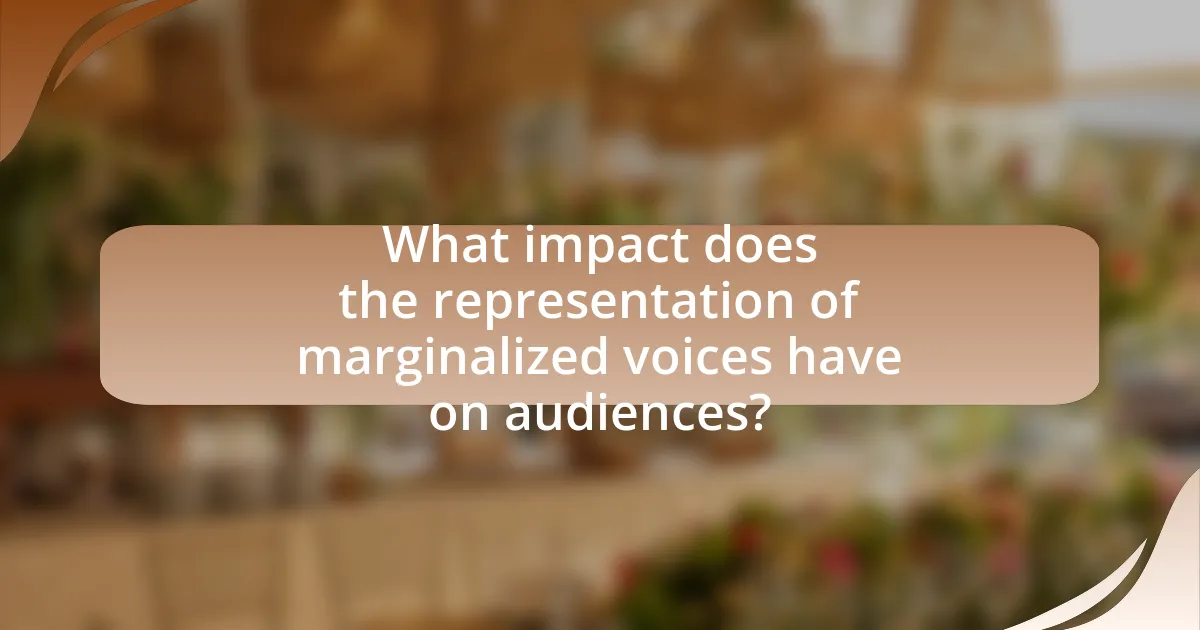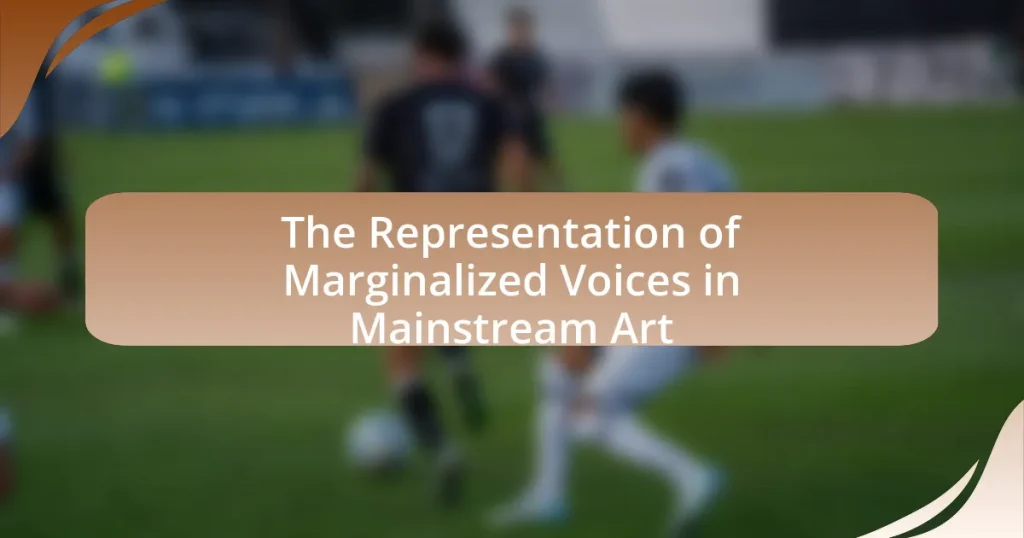The article examines the representation of marginalized voices in mainstream art, highlighting the historical and ongoing challenges faced by artists from racial minorities, LGBTQ+ communities, and women. It discusses the importance of inclusivity in art, emphasizing how diverse representation fosters empathy, challenges stereotypes, and enriches cultural narratives. The article also explores the impact of systemic barriers, tokenism, and the role of historical movements in shaping visibility for marginalized artists. Additionally, it outlines current trends, effective mediums for expression, and strategies for enhancing representation, ultimately advocating for a more equitable art world that amplifies diverse voices.

What is the Representation of Marginalized Voices in Mainstream Art?
The representation of marginalized voices in mainstream art is often limited and stereotypical, reflecting broader societal inequalities. Historically, artists from marginalized communities, such as racial minorities, LGBTQ+ individuals, and women, have faced barriers to entry in the art world, resulting in underrepresentation in galleries, museums, and major exhibitions. For instance, a 2019 report by the National Museum of Women in the Arts found that only 11% of artists in major exhibitions were women, highlighting gender disparities. Additionally, the art market tends to prioritize works by established, predominantly white male artists, which further marginalizes diverse voices. Recent movements advocating for inclusivity and representation, such as the #MeToo movement and Black Lives Matter, have prompted some mainstream institutions to reevaluate their practices and include more diverse artists, yet significant challenges remain in achieving equitable representation.
Why is the representation of marginalized voices important in art?
The representation of marginalized voices in art is crucial because it fosters inclusivity and reflects diverse human experiences. When marginalized communities are represented, their unique perspectives challenge dominant narratives and promote social awareness. For instance, studies show that art featuring diverse voices can lead to increased empathy and understanding among audiences, as seen in exhibitions like “Black Lives Matter” that highlight racial injustices. Furthermore, representation in art can empower marginalized artists, providing them with platforms to share their stories and contribute to cultural dialogues, thereby enriching the artistic landscape.
How does representation impact societal perceptions of marginalized groups?
Representation significantly shapes societal perceptions of marginalized groups by influencing public understanding and attitudes. When marginalized groups are accurately and positively represented in mainstream art, it fosters empathy, challenges stereotypes, and promotes inclusivity. For instance, studies have shown that diverse representation in media leads to greater acceptance and understanding among audiences, as seen in the increased visibility of LGBTQ+ characters in television, which correlates with improved societal attitudes towards LGBTQ+ individuals. Furthermore, the portrayal of racial minorities in films and literature can either reinforce harmful stereotypes or dismantle them, impacting how these groups are perceived in everyday life. Thus, representation serves as a powerful tool in shaping societal narratives and perceptions regarding marginalized communities.
What role does art play in amplifying marginalized voices?
Art serves as a powerful medium for amplifying marginalized voices by providing a platform for expression and visibility. Through various forms such as visual art, music, and literature, artists from marginalized communities can share their experiences, challenges, and cultural narratives, which are often overlooked in mainstream discourse. For instance, the works of artists like Frida Kahlo and Jean-Michel Basquiat have highlighted issues of identity, race, and gender, fostering greater awareness and empathy among broader audiences. Additionally, studies show that art initiatives focused on marginalized groups can lead to increased social engagement and community empowerment, as evidenced by programs like the “Art for Social Change” movement, which actively seeks to elevate underrepresented voices in society.
What are the historical contexts of marginalized voices in mainstream art?
Marginalized voices in mainstream art have historically been shaped by social, political, and economic factors that have excluded certain groups from representation. For instance, during the Renaissance, women and people of color were largely absent from the art canon, as the prevailing cultural narratives prioritized male European artists. The Harlem Renaissance in the 1920s marked a significant shift, as African American artists began to gain visibility and challenge stereotypes through their work, reflecting their cultural heritage and experiences. Additionally, the feminist art movement of the 1970s sought to address gender inequality in the art world, advocating for the inclusion of women’s perspectives and experiences. These historical contexts illustrate how marginalized voices have fought for recognition and representation, often in response to systemic barriers and societal norms that have historically silenced them.
How have historical movements influenced the representation of marginalized voices?
Historical movements have significantly influenced the representation of marginalized voices by creating platforms for visibility and advocacy. For instance, the Civil Rights Movement in the 1960s led to increased representation of African American artists in mainstream art, as seen in the works of artists like Jacob Lawrence and Faith Ringgold, who depicted the struggles and narratives of Black communities. Similarly, the feminist movement of the 1970s brought attention to women’s experiences in art, exemplified by artists such as Judy Chicago and the creation of “The Dinner Party,” which highlighted women’s contributions to history and culture. These movements not only challenged existing power structures but also prompted institutions to diversify their collections and programming, thereby amplifying marginalized voices in the art world.
What significant events have shaped the visibility of marginalized artists?
Significant events that have shaped the visibility of marginalized artists include the Civil Rights Movement, the Stonewall Riots, and the establishment of initiatives like the National Endowment for the Arts. The Civil Rights Movement in the 1960s brought attention to racial inequalities, leading to increased representation of African American artists in galleries and museums. The Stonewall Riots in 1969 catalyzed the visibility of LGBTQ+ artists, fostering a cultural shift that embraced diverse sexual identities in art. Additionally, the National Endowment for the Arts, founded in 1965, has funded projects that promote underrepresented artists, thereby enhancing their visibility in the mainstream art world. These events collectively contributed to a broader recognition and appreciation of marginalized voices in art.

How do marginalized voices manifest in mainstream art today?
Marginalized voices manifest in mainstream art today through increased representation in various mediums, including film, visual arts, and literature. Artists from underrepresented communities are gaining visibility and recognition, leading to a broader spectrum of narratives that challenge dominant cultural norms. For instance, the success of films like “Black Panther” and “Parasite” demonstrates how stories from marginalized perspectives can achieve critical and commercial acclaim, reflecting a shift in audience demand for diverse storytelling. Additionally, initiatives such as the #MeToo movement have prompted artists to address issues of gender and sexual identity, further integrating these voices into mainstream discourse. This evolution is supported by statistics indicating that diversity in art leads to greater audience engagement and financial success, as seen in the increased box office revenues for films featuring diverse casts.
What are the current trends in the representation of marginalized voices?
Current trends in the representation of marginalized voices include increased visibility and inclusion in mainstream art, driven by movements advocating for diversity and equity. This shift is evidenced by the rise of exhibitions and platforms dedicated to showcasing artists from underrepresented communities, such as the “Black Lives Matter” movement influencing art institutions to prioritize works by Black artists. Additionally, social media has become a powerful tool for marginalized artists to share their narratives and connect with broader audiences, leading to a democratization of art spaces. Data from the National Endowment for the Arts indicates that participation in arts programs by diverse groups has grown, reflecting a broader societal push for representation and recognition of varied cultural perspectives.
How are contemporary artists addressing issues of representation?
Contemporary artists are addressing issues of representation by actively incorporating diverse perspectives and experiences into their work, often focusing on marginalized communities. For instance, artists like Kehinde Wiley and Amy Sherald challenge traditional art narratives by depicting Black subjects in ways that reclaim agency and visibility, as seen in Wiley’s portrait of Barack Obama. Additionally, artists such as Ai Weiwei and Yoko Ono use their platforms to highlight social injustices and advocate for human rights, thereby fostering dialogue around representation. This approach is supported by initiatives like the 2019 “New Museum Triennial,” which showcased artists from underrepresented backgrounds, emphasizing the importance of inclusivity in contemporary art.
What mediums are most effective for expressing marginalized perspectives?
Visual art, literature, and digital media are the most effective mediums for expressing marginalized perspectives. Visual art, such as paintings and installations, allows for immediate emotional engagement and can convey complex narratives without the need for words. Literature, including poetry and novels, provides a deep exploration of personal and collective experiences, enabling marginalized voices to articulate their stories in nuanced ways. Digital media, particularly social media platforms, facilitates widespread dissemination and engagement, allowing marginalized individuals to share their perspectives directly with a global audience. For instance, the rise of hashtags like #BlackLivesMatter on platforms like Twitter has amplified voices that challenge systemic racism and injustice, demonstrating the power of digital media in advocacy and representation.
What challenges do marginalized artists face in mainstream art?
Marginalized artists face significant challenges in mainstream art, including systemic barriers, lack of representation, and limited access to funding and resources. Systemic barriers manifest in the form of biases within art institutions and galleries that favor established artists, often sidelining those from underrepresented backgrounds. The lack of representation is evident in the underexposure of marginalized artists in major exhibitions and art markets, which diminishes their visibility and opportunities for recognition. Additionally, limited access to funding and resources restricts their ability to create and promote their work, as many grants and sponsorships are often directed toward more recognized artists. These challenges contribute to a cycle of exclusion that hinders the diversity and richness of the art world.
How do systemic barriers affect the visibility of marginalized voices?
Systemic barriers significantly reduce the visibility of marginalized voices by creating obstacles that limit access to platforms and resources necessary for expression. These barriers include institutional discrimination, economic inequality, and cultural biases that favor dominant groups, thereby sidelining diverse perspectives. For instance, a study by the National Endowment for the Arts found that artists from marginalized communities often receive less funding and fewer exhibition opportunities compared to their counterparts, which directly impacts their visibility in mainstream art. This lack of representation perpetuates a cycle where marginalized voices remain unheard and underrepresented in cultural narratives.
What are the implications of tokenism in art representation?
Tokenism in art representation leads to superficial inclusion of marginalized voices without genuine engagement or support. This practice often results in the perpetuation of stereotypes, as artists from underrepresented groups may be showcased merely to fulfill diversity quotas rather than to highlight their authentic narratives. For instance, a study by the National Endowment for the Arts found that while diversity in art has increased, the depth of representation often remains shallow, limiting the impact of these artists’ work on broader cultural conversations. Consequently, tokenism can undermine the credibility of both the artists and the institutions that promote them, ultimately stifling meaningful dialogue about diversity and inclusion in the art world.

What impact does the representation of marginalized voices have on audiences?
The representation of marginalized voices significantly enhances audience empathy and understanding. When audiences encounter diverse narratives, they are more likely to develop a deeper awareness of the experiences and challenges faced by marginalized communities. Research indicates that exposure to such representations can reduce prejudice and foster social cohesion. For instance, a study published in the journal “Psychological Science” found that individuals who engaged with media featuring marginalized perspectives reported increased empathy and a greater willingness to support social justice initiatives. This demonstrates that the inclusion of marginalized voices in mainstream art not only enriches cultural discourse but also has a tangible impact on audience attitudes and behaviors.
How does exposure to diverse voices influence audience perceptions?
Exposure to diverse voices significantly broadens audience perceptions by fostering empathy and understanding of different experiences. When audiences engage with varied narratives, they are more likely to challenge their preconceived notions and biases, leading to a more nuanced worldview. Research indicates that exposure to diverse perspectives can enhance cognitive flexibility, allowing individuals to appreciate complexity in social issues. For instance, a study published in the Journal of Personality and Social Psychology found that participants who consumed media featuring diverse characters reported increased empathy and reduced prejudice. This evidence underscores the transformative impact of diverse voices in shaping audience perceptions and promoting inclusivity.
What are the psychological effects of seeing oneself represented in art?
Seeing oneself represented in art can significantly enhance self-esteem and foster a sense of belonging. This psychological effect occurs because representation validates individual identity and experiences, allowing viewers to feel acknowledged and understood. Research indicates that individuals who see their identities reflected in art report increased feelings of empowerment and reduced feelings of isolation. For example, a study published in the journal “Psychology of Aesthetics, Creativity, and the Arts” by authors Jennifer L. Aaker and Angela Y. Lee found that representation in art can lead to greater emotional engagement and a stronger connection to the artwork, ultimately contributing to improved mental well-being.
How can art foster empathy and understanding among different communities?
Art can foster empathy and understanding among different communities by providing a platform for diverse narratives and experiences. Through visual storytelling, music, and performance, art allows individuals to engage with perspectives outside their own, promoting emotional connections and shared experiences. For instance, community art projects that involve collaboration between various cultural groups can highlight common struggles and triumphs, thereby bridging gaps in understanding. Research by the National Endowment for the Arts indicates that participation in the arts can enhance social cohesion and empathy, as individuals are exposed to the lived experiences of others. This exposure can lead to increased awareness and appreciation of cultural differences, ultimately fostering a more inclusive society.
What strategies can be employed to enhance the representation of marginalized voices in art?
To enhance the representation of marginalized voices in art, strategies such as inclusive programming, community engagement, and equitable funding can be employed. Inclusive programming involves curating exhibitions that feature artists from diverse backgrounds, ensuring that their narratives are visible and valued. Community engagement can be achieved through workshops and collaborative projects that invite marginalized artists to share their experiences and perspectives, fostering a sense of ownership and representation. Equitable funding is critical; allocating resources specifically for projects led by underrepresented artists can help level the playing field, as evidenced by initiatives like the Ford Foundation’s support for artists of color, which has shown to increase visibility and opportunities for these creators.
How can institutions support marginalized artists effectively?
Institutions can effectively support marginalized artists by providing equitable access to resources, funding, and exhibition opportunities. For instance, implementing grant programs specifically aimed at underrepresented groups can help alleviate financial barriers, as evidenced by the success of initiatives like the National Endowment for the Arts’ funding for diverse artists. Additionally, institutions can create mentorship programs that connect marginalized artists with established professionals, fostering skill development and networking. Research shows that mentorship significantly enhances career advancement for artists from marginalized backgrounds, as highlighted in a study by the University of California, which found that 70% of mentees reported increased confidence and opportunities. Furthermore, institutions should prioritize inclusive programming that reflects diverse narratives, ensuring that marginalized voices are not only represented but celebrated in mainstream art.
What role do art critics and curators play in promoting diverse voices?
Art critics and curators play a crucial role in promoting diverse voices by selecting and highlighting artworks that represent underrepresented communities. Their influence shapes public perception and access to various artistic expressions, ensuring that marginalized artists gain visibility in mainstream art spaces. For instance, exhibitions curated by individuals committed to diversity can lead to increased recognition for artists from different cultural backgrounds, as seen in initiatives like the 2019 Venice Biennale, which featured a significant number of artists from diverse ethnicities. This intentional focus on inclusivity not only enriches the art world but also fosters a broader dialogue about identity and representation, ultimately contributing to a more equitable cultural landscape.
What are best practices for engaging with marginalized voices in mainstream art?
Best practices for engaging with marginalized voices in mainstream art include actively listening to and amplifying these voices, ensuring representation in decision-making processes, and providing platforms for their narratives. Engaging with marginalized artists requires collaboration that respects their perspectives and experiences, fostering an inclusive environment where their contributions are valued. Research indicates that diverse representation in art leads to richer cultural dialogues and broader audience engagement, as seen in initiatives like the “Art for All” program, which successfully increased visibility for underrepresented artists.










